Four Seasons in Japan
Autumn 秋
If you like this itinerary, you can order the book (or Kindle eBook) on your country’s Amazon* website: Amazon.co.uk | Amazon.com | Amazon.com.au | Amazon.de | Amazon.nl

Chapters 1 〜 7
Day 1 - Shirakawa-gō
Itinerary of the day
Photo gallery
Typical products and souvenirs
Soba 蕎麦, noren 暖簾 and other local souvenirs
At the souvenir shops of the village, among the typical products recommended there are certainly the soba boxes, complete with condiments and accompanying soy-based sauces. Famous are those of the Ota-san-chi brand prepared with local buckwheat.
Some of these shops also have small food and beverage corners, such as Oishinbo where you can eat local dishes and freshly prepared snacks. Others, such as Soba Wakimoto, are real restaurants that offer Shirakawa-gō soba in many variations served with seasonal ingredients.
Many shops such as Kataribe, a gift shop attached to the Koemon gasshō-style guest house, sell village-inspired sweets, cookies and snacks, while at Tezuka Neo you can buy Shirakawa-gō themed hand-painted noren, very decorative items. beautiful to separate the rooms in the house.
Other local souvenirs are the handicraft products in woven straw, obtained from the grasses also used for the construction of the roofs, and the pickled local vegetables, including the beni kabu-zuke, pickled red turnips of Hida preserved to be eaten during the harsh winter.
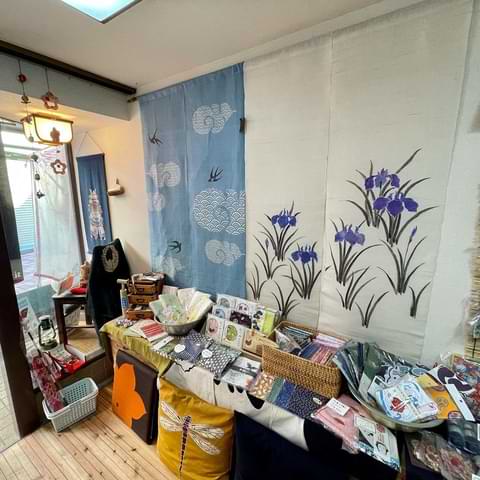
Doburoku どぶろく
Doburoku sakè is a type of unfiltered artisan sakè with a sweet taste and a lower alcohol content. It falls into the category of nigori-zake, or cloudy sakè, white and cloudy sakè in which the must is filtered through very porous fabrics and sieves, allowing rice residues to remain in the drink.
This sakè has been subject to the ban on production since the Meiji period, as the distillation process does not respect the alcohol production standards introduced at that time. However, during certain times of the year a license is granted to produce and consume it, such as during the Doburoku Matsuri.
Shops such as Memenko, located near the gasshō house “Wada House”, are famous for selling products based on this sakè, such as the Doburoku yōkan, a Doburoku sakè bean jelly.
Many of the village’s food souvenir shops sell collectible bottles of Doburoku sakè produced during the festival, while several other local sakè can be tasted in specialty shops such as Kodō Shōten.
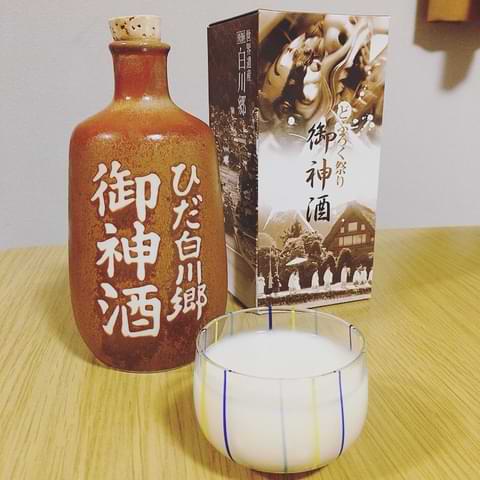
Useful links
Day 2 - Takayama
Itinerary of the day
Photo gallery
Typical products and souvenirs
Sakè 酒
Takayama is an optimal area for the production of sake as it is located between high mountains whose cool temperatures favor the fermentation of the rice, fermentation that takes place between the months of January and February.
The city’s six ancient distilleries are located in the Sanmachi-suji district, in the old city south of Yasukawa-dōri. In these distilleries it is possible to taste various types of for a few dollars, while between June and July the Nonbei Matsuri is held, a festival with prizes depending on the number of stamps obtained in the various distilleries.
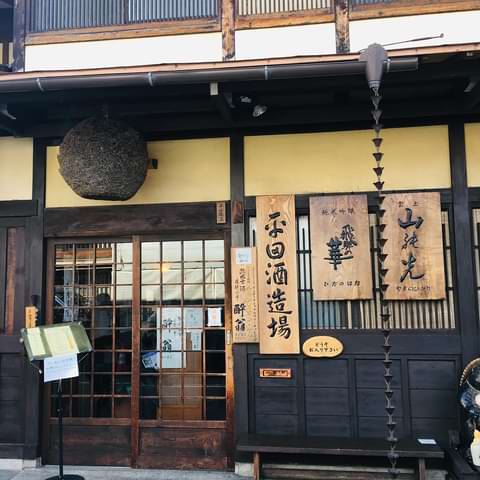
Hōba-miso 朴葉味噌
Hōba-miso is a delicious dish made from regional ingredients: Japanese hōba magnolia leaf, harvested in the fall and dried, Hida’s wagyū, leeks, mushrooms, onions and bean sprouts, all coated with miso salty paste. The dish is served raw and slowly cooked on the shichirin brazier at the table.
This cooking method originated as a way to thaw pickles that were frozen in the depths of winter. The large leaves of the magnolia obovata have antibacterial properties and in the Hida region they are used to wrap portions of sushi or mochi. When dry, the leaves are used to serve hōba-miso.
In the prefecture of Gifu there are several restaurants specializing in hōba-miso, one of the most popular is certainly Suzuya in Takayama. Other restaurants serve Hida wagyū cooked in different ways instead, including Takumiya Yasukawa where you can cook the meat directly on the barbecues at the table.
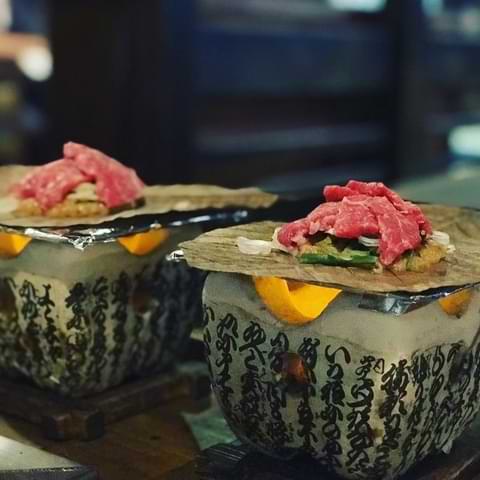
Hida-shunkei 飛騨春慶
Lacquered wood crafts are typical of the Hida region and in Takayama, especially in the districts of Sanmachi-suji and those north of Yasukawa-dōri, there are several shops selling fine products of this type.
The name is said to derive from the fact that the items initially produced were similar in color to the Hishunkei tea containers. In the Meiji (1868-1912) and Taishō (1912-1926) periods, the lacquer industry was mainly promoted by wholesalers, who exhibited their wares at foreign world fairs, making Hida-shunkei lacquer famous.
After a decline during the Second World War, due to the lack of supply of lacquer, during the period of economic growth after the war this craft was widely revived and in recent years the demand for lacquered objects as souvenirs for tourists has increased.
The clear lacquer enhances the grain of the wood, usually hinoki cypress, sawara cypress and Japanese horse chestnut. The wood, dried naturally, then undergoes various processing phases up to the application of multiple layers of raw lacquer and egomic oil and to the overpainting done according to the technique of the individual craftsman.
The impressive color of Hida-shunkei lacquer is a secret guarded by these craftsmen, each with their own formula for the composition of the lacquer. Therefore, the color tone varies subtly depending on the lacquer master.
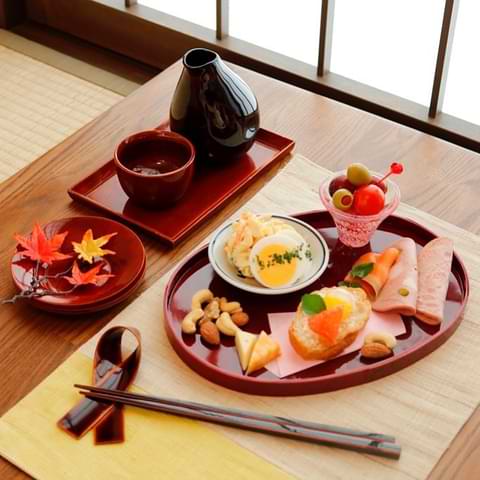
Yakimono 焼き物
Various styles of pottery have developed in Takayama and today several kilns (recognizable by the tall chimney pots) are located near the city.
A wide variety of these pottery can be found in the different shops of the Sanmachi-suji district, or at the large Takumi-kan handicraft shop which sells many different products typical of the Hida region.
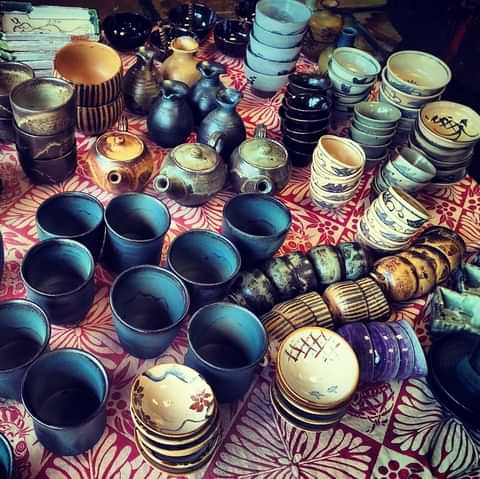
Kami-ema 紙絵馬
The kami-ema plates are auspicious amulets composed of horses hand painted on washi paper, a particular version of the classic ema painted on wooden plates that are found in many Japanese shrines and temples.
In ancient times, peasants from the region went to the Matsukura Kannon-dō temple to purchase these amulets, in order to protect livestock from disease or as an omen for a good harvest of silkworms.
Every year, on August 9 and 10, the kami-ema market takes place at Matsukura Kannon-dō temple, southwest of Takayama, or at Yamazakura-jinja Shrine or Sogen-ji Temple in Takayama City.
Today these kami-emas are bought as a wish for happiness and health for one’s family, as well as becoming a popular souvenir that can be purchased all year round at specialty stores such as Ikemotoya.
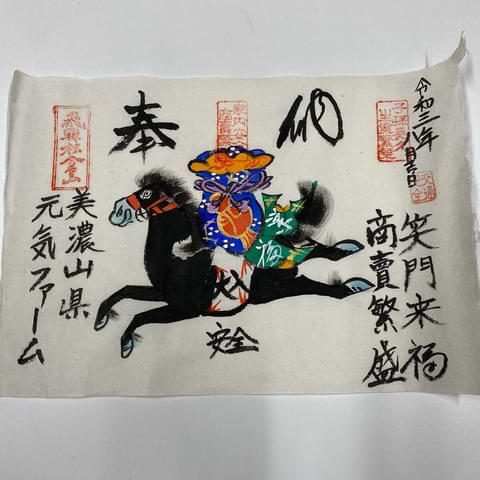
Useful links
Day 3 - Takayama
Itinerary of the day
Photo gallery
Typical products and souvenirs
Ichii Ittō-bori 一位一刀彫
The ichii ittō-bori are wood carvings of ichii. This style of wood carving developed in the Edo period and is made with ichii wood, the Japanese yew, a very common tree in the territory of the Hida region.
The objects made in this way are carved only with chisels and not colored, in order to bring out the natural beauty of the wood grain. The wood has a red-toned heartwood in the center and a white-toned sapwood on the outer rings. This coloring gives the wood carving pieces their individuality.
At one time these miniature sculptures were used as netsuke, that is small objects that served as buttons to hang pouches or tobacco pouches from the belt of the kimono, while today they are elements of furniture of unique beauty.
On the streets of Takayama there are several craft shops that sell them, particularly along Yasukawa-dōri Street, Ōmachi-dōri Street and Kokubun-ji Temple, such as Suzuki Chōkoku’s historic workshop.
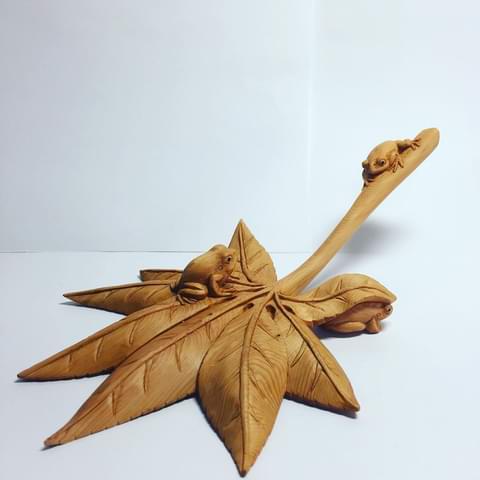
Shichirin 七輪
The term shichirin refers to the small braziers that are easy to move and generally run on coal. In Takayama restaurants, a traditional diatomaceous earth version, Keisōdo, is used mainly to cook hōba-miso at the table.
Shops that sell miso and other kitchen ingredients and accessories often carry this item, such as Haruji Shibata Shōten.
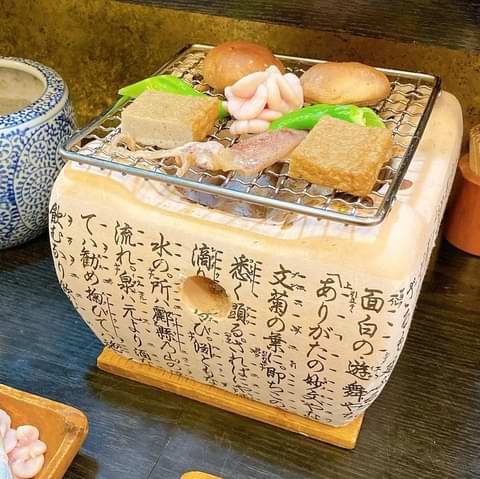
Sarubobo さるぼぼ
Having become the mascotte of Takayama city, Sarubobo dolls are now a popular souvenir among tourists. The name means “baby monkey” and they were born as a good luck charm made by grandmothers for the birth of children or to ward off evil.
In addition to the traditional red, they can be found in various colors, depending on the type of luck you want. In Takayama they are found almost everywhere and real workshops are organized to create them.
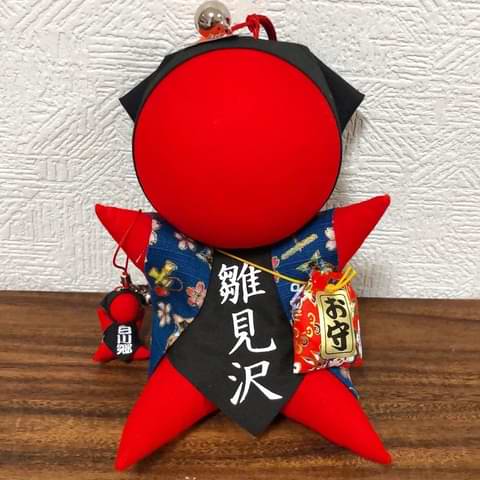
Useful links
We really hope that reading is thrilling you!
If so, we would be very grateful if you could leave a star rating or a short review to the book on amazon, not having a publishing house behind it would be of great help!
Also, don’t hesitate to let us know your impressions on Instagram and Facebook using the hashtag #fourseasonsinjapan or by tagging @cuor.di.manju in your posts/stories.
Day 4 - Kanazawa
Itinerary of the day
Photo gallery
Typical products and souvenirs
Kinpaku 金箔
Kinpaku are very fine gold leaves, 1/10000 mm thick, used as decorations for objects, to embellish dishes and sweets and even in personal care products.
The name of the city of Kanazawa, according to an ancient legend, derives from the expression “golden swamp” and has always held the exclusive in the production of kinpaku in Japan, so much so that in the city there is the Yasue Museum, completely dedicated to Kanazawa gold leaf!
Gold leaves are widely used on sushi, to coat jellies and candies, on ice creams and cakes, so much so that certain sweet shops have made their products famous as typical souvenirs of the city. One example is the Kanazawa kasutera from the Mameya sweet shop.
However, around the city there are also shops and perfumeries that sell skin masks and lotions based on gold leaf. Shops such as Imai Kinpaku specialize in wooden objects decorated with gold leaf and organize workshops to produce their own souvenirs.
In the old quarter of Higashi-chayagai there are tea houses and kinpaku themed places. An example is the beautiful restaurant of Hakuichi which, in addition to selling elegant accessories and products in gold leaf, offers “golden” ice cream and tea in its evocative setting and the opportunity to visit an entire room covered in gold with the center an equally sparkling samurai armor.
Also in the old quarter, a visit to the gold tatami Kaikaro Tea House is recommended, or to the Sakuda and Hakuza shops which, in their elegant shops, have entire rooms covered in gold.
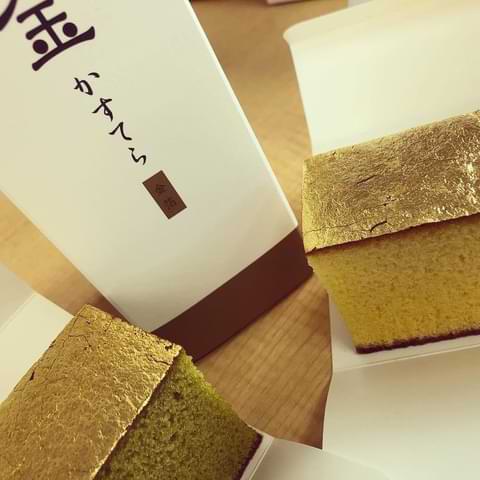
Hanton-raisu ハントンライス
The hanton-raisu (“rice” trasposed in Japanese language) is a variant of Omurice, one of the most popular dishes of Japanese cuisine in which the rice is stir-fried with vegetables and topped with a not fully cooked omelette. In the case of hanton-raisu, the dish is completed with delicious fried cod, tartar sauce and ketchup.
Grill Ōtsuka, near the Kanazawa garden, is a historic place founded in 1957, which prepares a low-priced hanton-raisu following the classic recipe with the addition of shrimp and a homemade tartar sauce, very creamy and not very acidic.
Many restaurants offer alternative variations of this dish, which can be characterized by the addition of fried prawns, pork cutlet or specific sauces.
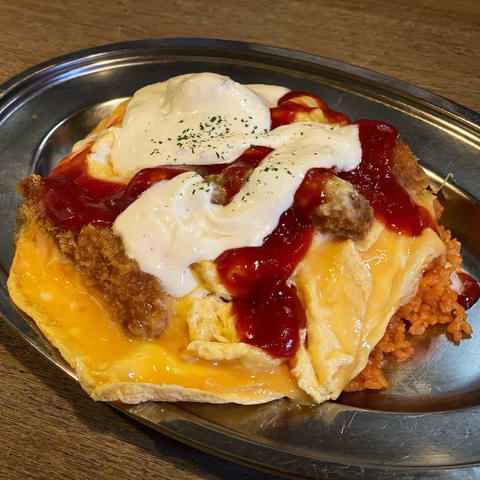
Kaisendon 海鮮丼
Kaisendon is a donburi, a rice-based bowl, topped with fresh sashimi and other ingredients. Rice, unlike other dishes such as chirashi-zushi, is not seasoned with vinegar.
In Kanazawa, also due to its proximity to the sea, this fresh dish is very popular in its classic variant accompanied by wasabi and soy sauce, which can be poured over rice or left aside to dip the fish separately.
Most of the restaurants where you can try this dish are around the Ōmichō-ichiba market, where they stock up on the delicious fish caught in the area. Within the market itself, some of these fishmongers prepare this dish to take away, like Kaisendon Ichiba for example.
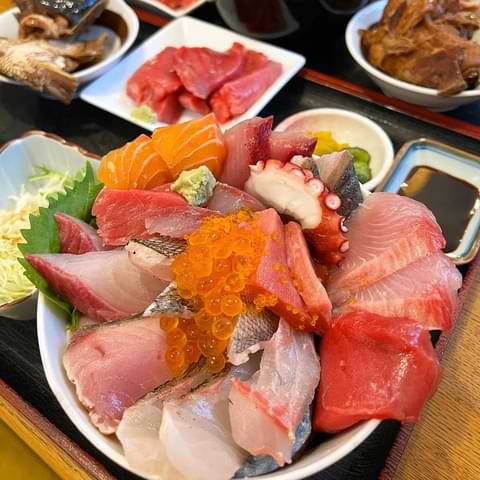
Kanazawa-shikki 金沢漆器
Kanazawa-shikki is a type of lacquer typical of Ishikawa prefecture, of which Kanazawa is the main city. These lacquers spread at the behest of the feudal lords of the Kaga clan during the Edo period, one of the wealthiest clans of the time.
The lacquering technique, imported from China and whose use was common in embellishing samurai armor, takes the name of maki-e and consists in decorating the lacquer with drawings made by sprinkling powder of gold, silver or other materials on the fresh lacquer.
Even today, many fine household items, tea ceremony items and flower arrangement vases are produced with this technique that contemplates extensive use of kinpaku gold leaf inside.
These precious products can be purchased at special shops specializing in the typical crafts of the city, such as the Kanazawa Craft Hirosaka, and are very easy to find in the shops of the old quarter of Kanazawa, the Higashi-chayagai district.
Products using this lacquering technique can also be admired at the Museum of Traditional Products and Crafts.
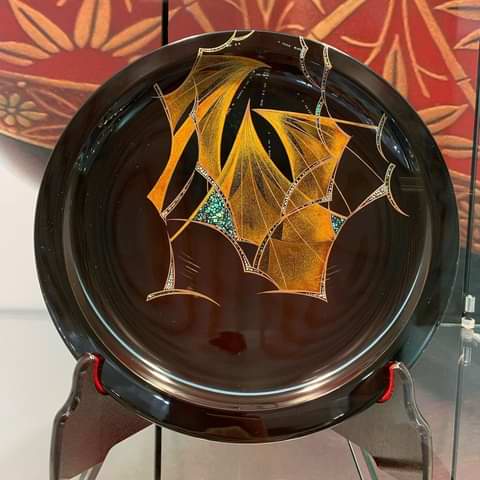
Kaga-mizuhiki 加賀水引
Mizuhiki are decorative strings used to embellish cards, postcards and gifts. They are made with traditional Japanese washi paper cut into long, thin strips and then intertwined like threads of a fabric. The weave is then hardened with a paste of glue based on algae and white clay dissolved in water.
What makes kaga-mizuhiki really fascinating are the many different colors of paper used together with gold and silver leaves. The colors of the paper are chosen according to the meaning and type of recurrence, as well as the type of decorative knot that characterizes the decoration.
The mizuhikis of the Kaga region are known for their beautiful designs of plums, bamboo and pine trees, or they can also be in the shape of cranes or turtles, auspicious and long-lived animals for oriental symbolism, or represent articulated coats of arms.
The Kanazawa Craft Hirosaka is one of the region’s souvenir stores where you can buy these handicrafts, while the Tsuda Mizuhiki shop, near the historic ninja district of Nishi-chayagai, specializes in this type of decorations and sells different types, some of which are real works of art.
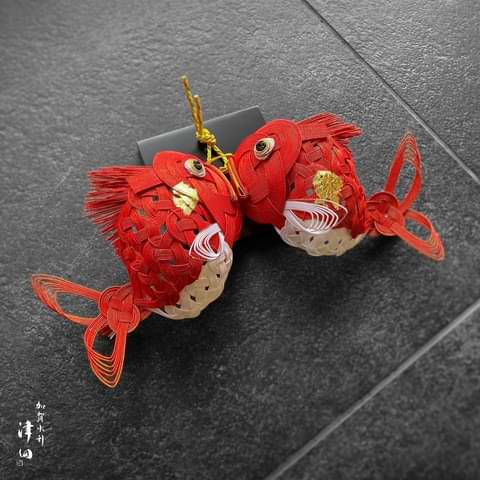
Ōmichō-korokke 近江町コロッケ
The Ōmichō-korokke are famous Japanese potato croquettes, usually breaded with panko and stuffed with the most disparate ingredients. Now widespread everywhere and typically served at festival stalls, they are one of the foods you absolutely must try when passing through the Ōmichō-ichiba Market in Kanazawa.
The korokke shop is easily recognizable thanks to the nice sign in the shape of a round and smiling croquette, near the west entrance of the market. Remember to pay attention to the mentaiko taste…
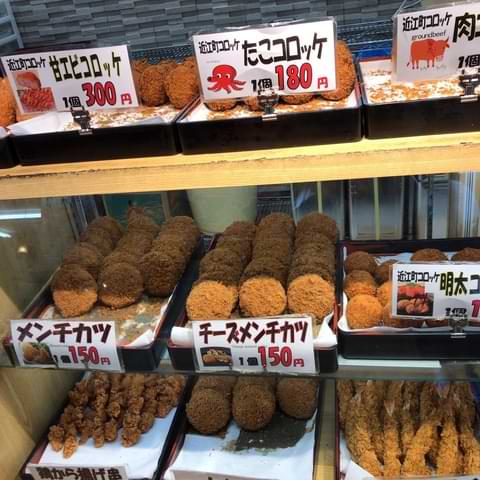
Kutani-yaki 九谷焼
Kutani-yaki are very brightly colored pottery typical of Ishikawa prefecture, recognized as one of the most popular porcelain styles in the country. Made in the city of Kaga and its surroundings, south of Kanazawa, they are obtained through a traditional method of painting and enamelling known as uwaetsuke.
The striking and bright pigments of Kutani-style porcelain, which distinguish them from other Japanese ceramics, are the result of the glazing method through which the craftsmen apply their beautiful designs. This process involves the application of colors after a first firing in the ovens. The ceramics are then put back into the kilns to imprint and protect the design in the final step.
Five traditional colors are used for the colors, the gosai-de, or deep red, yellow, green, purple and blue, which give rise to bold and picturesque designs.
Based on which of these 5 colors are used, the various ceramics are divided into aote, which does not use red, iroe, which uses all five, and akae, which uses only red.
There are several craft shops that sell these ceramics, such as the Ishikawa Local Products Center or the neighboring Kutani Tomoe, both close to the Kanazawa garden.
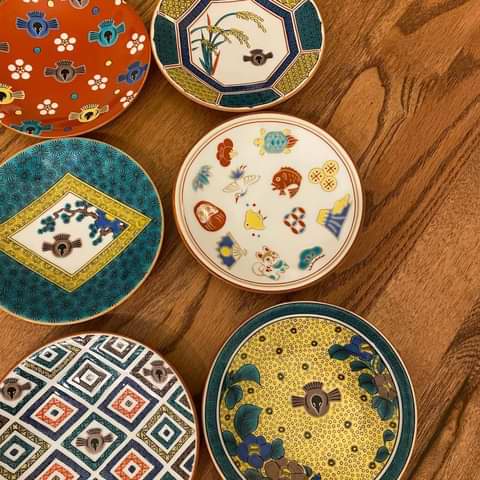
Useful links
Day 5 - Nagoya
Itinerary of the day
Photo gallery
Typical products and souvenirs
Miso-nikomi udon 味噌煮込みうどん
Miso-nikomi udon is a rich soup made from vegetables, udon, chicken, egg, fish pie (kamaboko), shiitake mushrooms, long green onions (negi) and fried tōfu (aburāge) in a miso-based broth. It is often served in the donabe, a traditional Japanese clay pot, in order to continue cooking or maintain the heat at the table.
The dish can be eaten in almost any udon restaurant in Aichi prefecture. In addition to the famous local Yamamotoya Ōkute, which prepares its delicious udon by hand, there are Nikomi-no-Takara and Makotoya, both historic places with their own style of this dish.
Finally, packaged udon to be made at home also have a history of over half a century and are very popular as souvenirs.
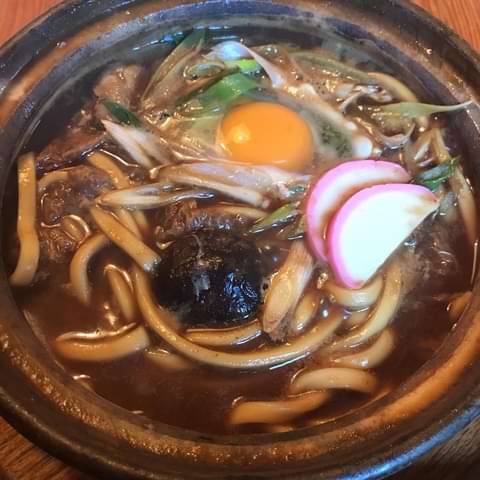
Misokatsu 味噌カツ
Misokatsu is a particular version of the delicious Japanese tonkatsu, that is the pork cutlet breaded in panko and fried, widespread by the historic Yabaton restaurant chain in Nagoya since the late 1940s.
In this recipe the cutlets are accompanied, instead of the usual sweet and spicy sauce of the traditional tonkatsu, by a sauce based on hatchō miso, a dark red miso paste.
Nagoya and its surroundings are famous for this particular miso, which is traditionally made with soybeans with no added grains, steamed rather than boiled and with at least two years of fermentation. The resulting miso has an intense and rich flavor, also known as the “emperor’s miso”.
The Yabaton chain has many restaurants in Nagoya and major cities in Japan. The most easily accessible, when visiting Nagoya, is the Yabaton restaurant at the city station, on the ninth floor of the Meitetsu department store.
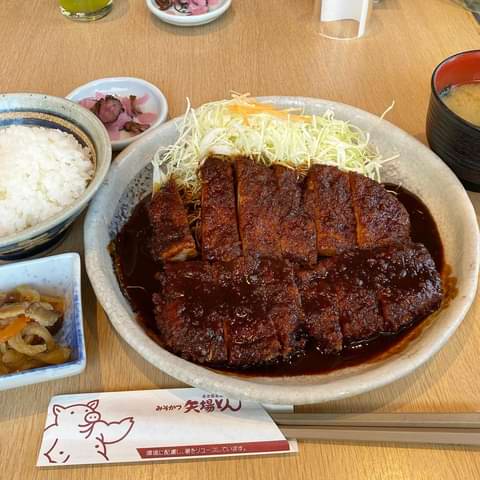
Hitsumabushi ひつまぶし
Hitsumabushi is a variation of the unagi donburi, popular throughout Japan. Unlike the latter, where the eel is placed in long slices on the rice, in this dish the eel is previously cut into small bites and accompanied by the appropriate sauce and nori seaweed.
The eel used is kabayaki prepared in the style of the Kansai region, cooked on the grill and not steamed. In this way, the well-browned skin remains crunchy while the fatty meat becomes tender and soft.
The name of the hitsumamushi dish became a registered trademark of the Atsuta Hōraiken restaurant in 1987, the restaurant that first began serving this dish originating from the Meiji period. The dish is served in a small ohitsu, a container for cooked rice, and is traditionally eaten following a three-step ritual.
First, the rice is portioned into the bowl and part of it is eaten as is. A second serving is then eaten with condiments, such as wasabi, nori seaweed or mitsuba, Japanese wild parsley. The last portion is served like the second, but with sencha tea or broth poured over it and is eaten like chazuke, rice soaked in green tea.
Maruya Honten, on the ninth floor of the Meitestu department store in Nagoya station, is one of the recommended restaurants to try it out. While if you’re willing to book well in advance or face long lines, eating at Atsuta Horaiken‘s historic eatery is well worth the effort. The venue currently has several locations, one of which is located near the Atsuta-jingū Shrine.
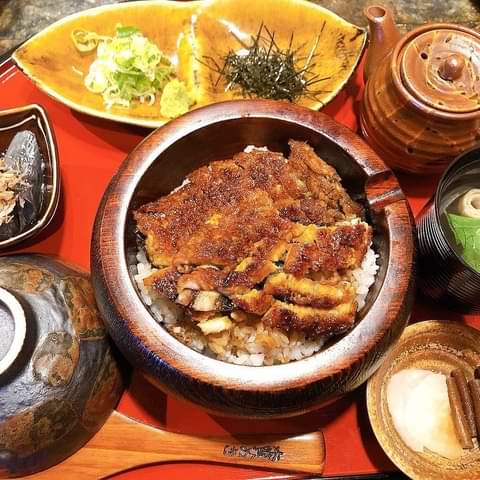
Kishimen きしめん
Kishimen is one of the three most famous types of udon in Japan. Very similar in appearance to Italian noodles but definitely more slippery, these udons are also called hirauchi udon and are a specialty of Aichi prefecture.
The basic ingredients are water, flour and salt, the same as regular udon, but the dough is rolled out to thin and flat, which takes less time to boil and helps absorb the soup’s flavor.
Just like regular udon, kishimen can be enjoyed in a hot soup made from soy broth or red miso, with nori seaweed, spinach, fish paste, fried tofu and katsuobushi, or cold with a savory dipping sauce.
In Nagoya, during a visit to the famous Atsuta-jingū shrine of the city, Miya Kishimen‘s kishimen is recommended, where you can also buy souvenir packages to prepare it at home.
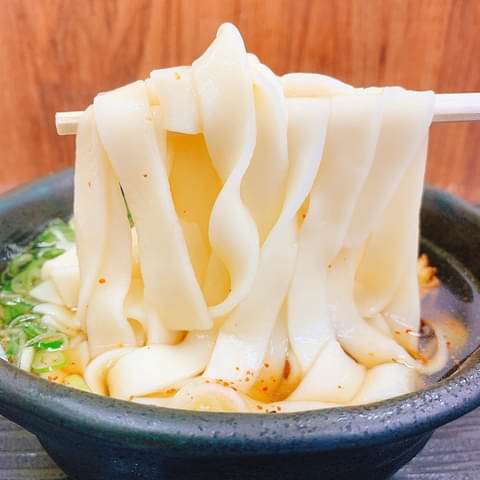
Useful links
Day 6 - Nagoya & Okayama
Itinerary of the day
Photo gallery
Typical products and souvenirs
Demi-katsudon デミカツ丼
The demi-katsudon is a local version of katsudon, the pork cutlet fried in panko and placed on a bed of rice, over which a demi-glace sauce and peas are poured. The dish was invented by the founder of Ajitsukasa Nomura, an Okayama restaurant, when he was an apprentice chef at a hotel in Tokyo.
The ingredients used for the sauce vary from shop to shop, and include dried sardine and chicken broth, consommé, Chinese soup, Worcestershire sauce, ketchup, miso and soy sauce.
Given the proximity to the station, it is recommended to eat this dish right in the historic restaurant of Katsudon Nomura.
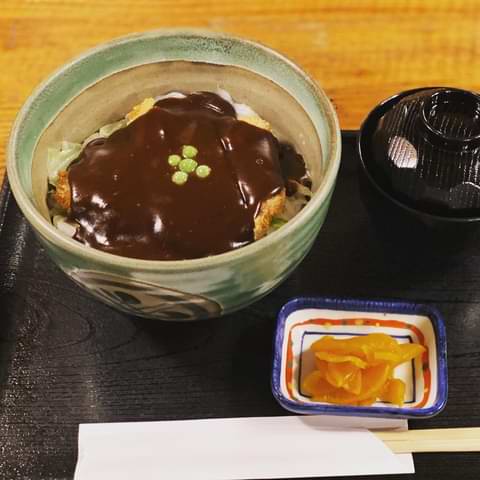
Ōte-manjū 大手饅頭
Ōte-manjū is a small sweet made from glutinous rice and azuki bean paste, very popular in and around Okayama. Ideal to accompany green tea, it can be enjoyed hot in its production factory just outside the city, in the Omachi district.
Founded in 1837, the company had a store near the Ōte-mon gate of Okayama Castle, from which the dessert got its name. Even today, the factory is delighted by the scent of its filling, koshi-an, a bean paste made from Hokkaidō azuki beans mixed with granulated sugar. The filling is placed in a thin dough casing and steamed. Everything is flavored with amazake, a sweet drink made from fermented rice similar to sake.
Over the years, this dessert has become so famous that it can also be found in the most well-stocked souvenir shops in the city.
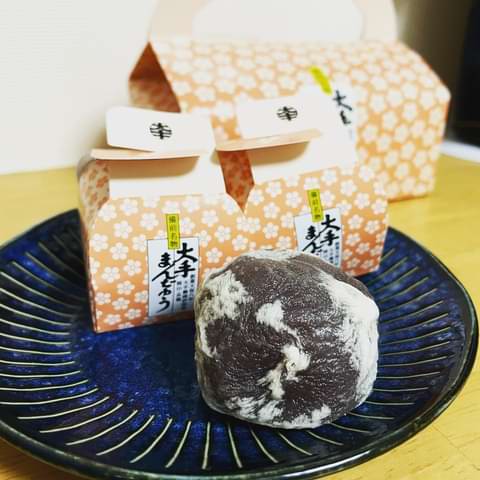
Shimizu Hakutō 清水白桃
Among the many varieties of peaches present in Japan, the white peach Shimizu Hakutō is considered the best ever. Grown exclusively in the Okayama area, where the climate is mild as it is influenced by the sea, there are numerous fruit crops to become the symbol of the city.
Its origin dates back to 1875 when two superior varieties of peaches, the Tianjin honey peach and the Shanghai honey peach, were brought to Japan from China, where the fruit was widely cultivated and considered a symbol of good luck.
In 1899, Okayama fruit researcher Jugoro Okubo created this variety using Shanghai honey peach seedlings, and it quickly became popular throughout Japan for its rich sweetness and milky pink and white skin, reaching a record figure of 5,000 yen for a single fruit.
From this white peach, many other hybrids were created which, starting from the postwar recovery, have become more and more famous and appreciated in the Okayama area, making it in effect the city of the peach.
To increase its fame there is also the folkloric story of Momotarō, a child born from a giant peach who, when he reached adolescence, left his parents to fight a band of demons (Oni) who plundered their land, going to find them on the island of Onigashima (the current island of Megijima, off Takamatsu, where the Oni cave can be visited).
Along the way, Momotarō befriended a dog, a monkey and a pheasant who, in exchange for his kibi-dango, agreed to help him on his mission. Defeated the enemies, Momotarō and his new friends returned home with the treasure plundered by the demons.
Today Okayama white peaches are also known as “the best flavor in Japan”, they are juicy and taste fresh and sweet and are mostly eaten fresh. Obviously, in the city it is also possible to buy peach-flavored desserts or containing its tasty jam, but also drinks and sake based on the fruit.
Near the city, every summer the fruit picking of peaches and other fruits is very popular. Farms such as Tomomien Fruit Farm and Yoshii Farm invite visitors to their own peach orchard where they can pick peaches and eat them on the spot. By reservation, several options for fruit picking are available, including limited-time all-you-can-eat plans and others that allow visitors to take home the peaches collected as souvenirs.
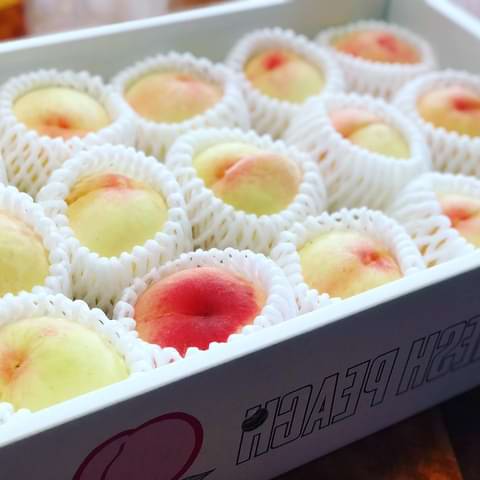
Murasuzume むらすずめ
Murasuzume are a type of crepes popular in Okayama city, invented in the adjacent town of Kurashiki. The egg, sugar and flour dough is lightly cooked and closed around the azuki bean paste. In this way the very spongy moist outer layer combined with the bean paste inside creates a really delicious texture.
Many shops, particularly in Kurashiki, offer visitors the chance to create their own handmade murasuzume. In Okayama, these sweets are sold packaged in souvenir shops, such as Omiyage Kaido and other shops on the 2F floor of the Sun Station Terrace shopping center, at Okayama station.
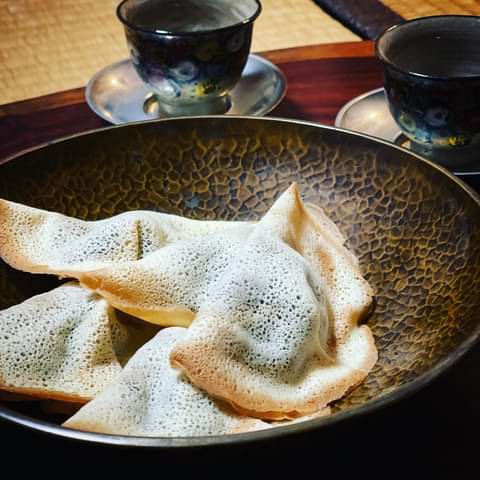
Kibi-dango 黍団子
Kibi-dango is very famous for being the favorite snack of Momotarō, the baby born from a peach, the icon of Okayama. According to legend, it was with the kibi-dango that he was able to recruit his trusted animal friends to defeat evil demons.
The name kibi has an uncertain origin as it could derive from a variety of millet called kibi, used in the past for the dough, or from the ancient name of the Okayama region, or the province of Kibi.
The dessert is a sweet and sticky ravioli made with millet flour, rice flour and sugar. The original recipe does not include any filling. However, in recent years, kibi-dango can be found with a mixture flavored with local fruit, such as grapes or peach-flavored syrup.
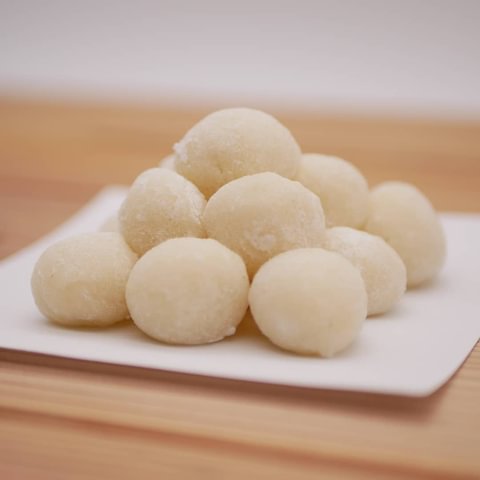
Bara-zushi ばら寿司
Bara-zushi, although considered a poor sushi, is a dish known for special occasions, similar to donburi but composed of a large bowl of rice and covered with many different fish and vegetables.
The dish was born during the Edo period in response to an order of the feudal lord of the time that required to limit oneself to one bowl of soup and one of food at each meal. So the citizens created a simple dish that combined fish and mountain vegetables, masking them with a large portion of rice.
It is also called matsuri-zushi as it is omnipresent in parties and celebrations, quick to prepare and very popular especially in spring, when in homes it brightens the table during the period of diplomas and new academic years, or during the festival of girls, the ‘Hina Matsuri, thanks to colorful ingredients such as kinshi tamago, finely chopped egg into strips, and merci shōga, ginger marinated in umeboshi plum vinegar.
The vegetables used in the dish depend on the period. Popular ingredients are kanpyō (dried gourd), lotus roots, koyadōfu (dried tōfu), carrot and shiitake mushrooms. An easily accessible restaurant where you can try this dish is Azuma Sushi Sun, at Okayama Station.
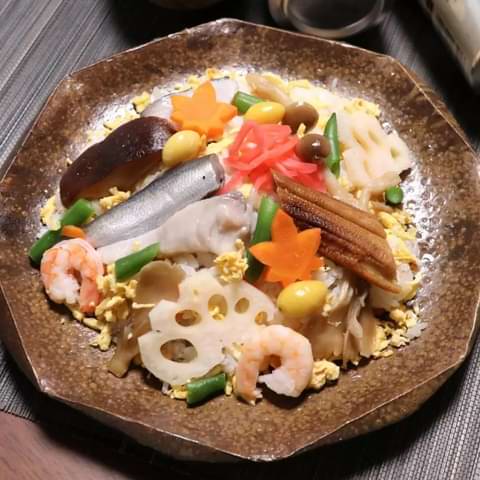
Useful links
We really hope that reading is thrilling you!
If so, we would be very grateful if you could leave a star rating or a short review to the book on amazon, not having a publishing house behind it would be of great help!
Also, don’t hesitate to let us know your impressions on Instagram and Facebook using the hashtag #fourseasonsinjapan or by tagging @cuor.di.manju in your posts/stories.
Day 7 - Hiroshima & Itsukushima
Itinerary of the day
Photo gallery
Typical products and souvenirs
Hiroshimayaki 広島焼き
Okonomiyaki originated in the pre-war period as a quick snack at street food stalls and okamisan restaurants, that are restaurants run by women alone. Over time the recipe was perfected and ingredients such as cabbage, eggs, seafood and pasta were added to what was initially a flour pancake with onions and dried shrimps to increase its nutritional value in the post-war period.
The name derives from the fact that the original ingredients were not always easy to obtain and many restaurateurs began to prepare it “cooked as you like”, ie “okonomiyaki”, using whatever ingredients were available.
In appearance it can appear as a kind of fusion between okonomiyaki and yakisoba: it is cooked by layering cabbage, bean sprouts, meat or fish, eggs and pasta (soba or udon), on a thin crepes. This cooking method makes it noticeably different from the classic Osaka-style okonomiyaki, which is cooked by immediately mixing flour dough with the other ingredients.
There are more than 2000 hiroshimayaki restaurants in Hiroshima, some highly recommended for the amount of variations on offer, such as Fumi-chan for example. The place par excellence to try this dish is Okonomimura, a building full of restaurants who cook exclusively this dish, and Hiroshima Okonomi Monogatari Ekimae Hiroba, near the station.
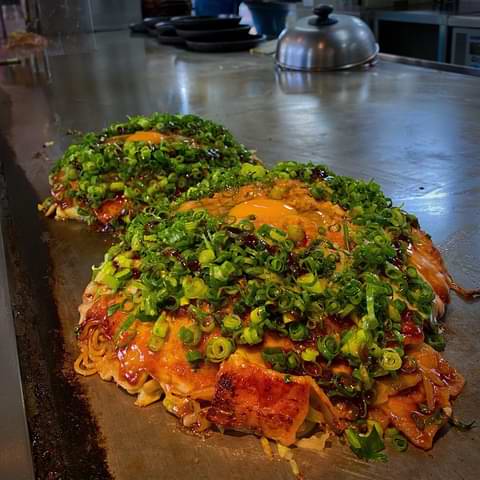
Hiroshima e Onomichi rāmen
Hiroshima rāmen is characterized by a broth made from soy sauce, pork and chicken with the addition of vegetables. The charm of this rāmen lies in its light, refreshing and traditional flavor.
Onomichi rāmen, another very popular rāmen in the city but coming from the nearby town of Onomichi, has a soup made with soy sauce, chicken and small fish from the sea it overlooks. The accompanying condiments are spring onions, chāshū (pork) and bamboo shoots.
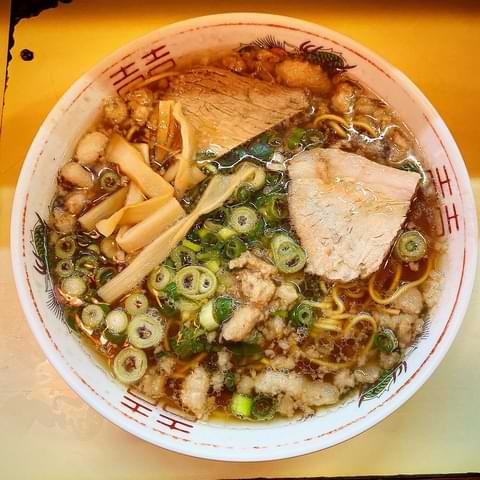
Momiji-manjū 紅葉饅頭
Momiji-manjū are fluffy sweets made from a dough made from wheat, eggs, sugar and honey in the shape of a maple leaf. They are filled, in their traditional variant, with anko koshi-an jam (azuki beans), or with various creams such as chestnuts, custard, chocolate, green tea etc.
It is a specialty and typical souvenir of Miyajima, although today it is well known and widespread nationally as a pastry and souvenir dessert representative of the entire Hiroshima prefecture, whose popularity increases in the autumn season.
The sweet was invented by Tsunesuke Takatsu, a Japanese confectionery craftsman who in the second half of the Meiji era supplied wagashi to a ryokan located in the famous tourist area of the park full of maple trees Momijidani-kōen, on the island of Miyajima, who worked in creating a sweet memory suited to the name of the park itself.
The original Momiji-manjū is still produced and sold at the port of Miyajima-guchi at the Takatsudō shop, along the San’yō coast, while on the island of Miyajima there are many shops that sell freshly baked momiji-manjū, such as Sakamoto Kashiho , which offers its customers a good tea together with the sweets purchased.
You can also buy them at Okinadō, where you can indulge in gift boxes and flavors, but also in generic souvenir shops near the Hiroshima malls.
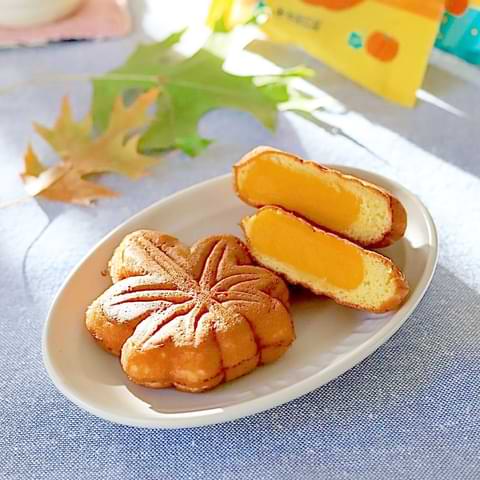
Shakushi 杓子
Shakushi are the wooden scoops used to pour rice into bowls. In Miyajima, where wood craftsmanship is very popular thanks to the particular processing that enhances the natural grain of the material, these palettes have become a symbolic and popular souvenir as they are artistically carved and associated with good luck.
Shops on the island offer a wide variety of shakushi, from those meant for royal use to decorative ones that you can engrave your name or message on to use as a postcard.
The Shakushi-no-ie shop on the main shopping street Omotesandō-shōtengai, specialize precisely in the processing of this object and sell pieces for all occasions. In the shop it is also possible to admire the Ōshakushi, the largest rice paddle in the world and whose creation took 2 years of work.
At the Miyajima Craft Center on the island you can also participate in workshops to make your own shakushi.
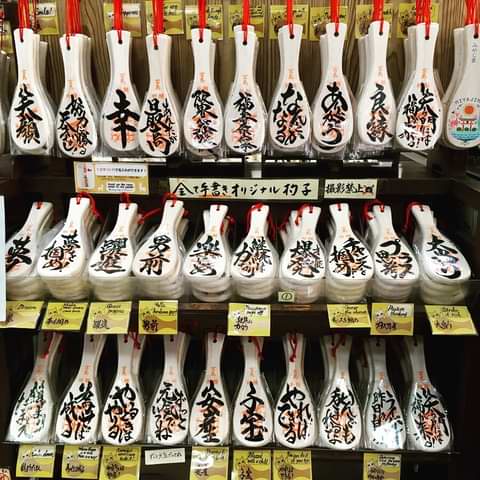
Kaki 牡蠣 (ostriche)
The stretch of the Seto Sea that separates Hiroshima from Miyajima Island is dotted with oyster farms. For this reason, oysters are the most famous of Hiroshima’s seafood dishes, as well as a popular product renowned above all for its above-average size, tenderness and juiciness.
The Miyajima Oyster Festival is held in February, in the winter season considered the best to savor this specialty. The event is organized in front of the Miyajima pier where, once you get off the ferry, you are attracted by the fragrant aroma of fried oysters. In addition to these, other oyster dishes such as oyster okonomiyaki and hot oyster stew are prepared and served.
Throughout the year, it is possible to taste oysters in the restaurants of Hiroshima and Miyajima, although in the latter it is recommended to taste them between one street and the other at the street vendors who, in addition to serving them raw, prepare them on the grill or skewered, usually with lemon or a light drizzle of soy sauce.
Famous on the island is the Yakigaki-no-Hayashi restaurant which, at affordable prices, serves local oysters prepared in all possible variations and in truly unique thematic dishes.
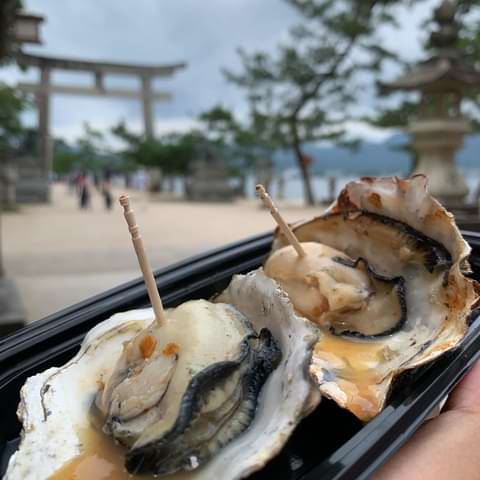
Useful links
* to cover the website costs, Onigiro uses Amazon Associate links. If you buy books or other things logging into Amazon through our links, we’ll receive a little commission without any cost for the buyer.


